INTRO:
As a primer, “sandbox” games let the player mess with the game world and build things for whatever purpose. They may have overarching goals, but the player is given plenty of freedom – and space – to achieve them however they see fit, or to be more precise, whatever their whims decide.
Minecraft was perhaps the one that popularized this genre, it being accessible, frequently updated (during its early years) and such other plus-points. Others would come later.
Yet, the major setback of these earlier sandbox games is that they relied on graphical designs that are easy on computers, if only so that the game world does not consume too many computing resources. They do not look great, if they are perceived with present-day standards.
Astroneer intends to rectify that. Instead of depending on cubes with ugly textures, Astroneer uses voxels, which provide for a lot more graphical pizzazz than those games of yore.
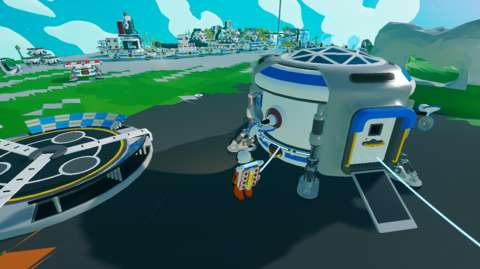
PREMISE:
There is not a lot of story in this game. Any little story that is there is not well-narrated either. The only discernible bit is that the player character begins the playthrough in a vessel that is owned by what is presumably a corporation, which goes by the name of “EXO Dynamics”. Indeed, a lot of the tech that the player character would use have the colour scheme that is favoured by this organization, if they do not outright have its label.
That said, there is an EXO Dynamics space vessel that is lingering in a solar system that is presumably not the one that it came from. The space vessel is automated. It is also holding many capsules, each containing what is presumably a dormant astronaut; the player character is one of these.
It preps the capsule that contains the player character, and launches it at a verdant planet by the name of Sylva (though the new player would not know this until later). The player character steps out of the small shelter that the vessel has prepared, and is then left to its own devices as to what to do.
There is an end-game to be achieved in the playthrough. However, the ending cutscene does not give much of any explanation as to what is happening. Apparently, this was deliberate on the developer’s part, just so players can speculate as to what is happening.
THE WORLDS:
The worlds in the solar system are evidently not the ones that the player character came from. The player character cannot breathe the air in their atmosphere (if there is any) and there is little evidence that civilizations have developed these. There are remnants of past EXO Dynamics expeditions, including corpses of other astronauts, so the player character is definitely not the first sapient being to step foot on them.
Strangely, the worlds completely lack any mobile fauna. They are not without dangers, of course; they have dangerous flora, and their terrain can be incredibly treacherous.
The worlds are arranged concentrically around a sun, which the player cannot visit (of course). Each seems to have climate and geology of its own; indeed, the Early Access version of the game has planets with hazards that are unique to them. (These have since been removed, due to the lack of reliable means for players to deal with them.)
Curiously, there is a satellite that is orbiting around one of the worlds; it is clearly not a moon. This happens to be part of the endgame content, but the player is not informed about this in any way.
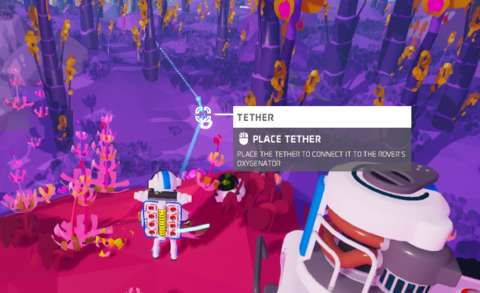
THE EDIFICES:
Even though there are no clear signs of civilization, there are clearly unnatural edifices that are on these worlds. They are arranged in a notably ordered manner: two of these are at the poles of each world, and if the world is larger than a moon, another four around its equator.
Each one is sending a beam of light out into space. If the clouds are not obscuring them, they can be seen from orbit. The beams of light are the player’s main means of locating them, if the clouds are not blocking them.
As for why the player would even want to interact with them, this is not told to the player. The new player, without having searched third-party guides and forum threads for what they do, would have to figure out what they do first-hand.
One particular oddity about them is that they have daises that have sockets. These sockets can seem out of place among the otherwise otherworldly appearance of the rest of the edifices. In fact, the sockets can seem rather familiar, because the player character’s tech has the same sockets too. It is unclear whether this is part of the narrative, or just something put in place so that new players can figure out what to do with the edifices.
There will be more explanation on the edifices later, because they are part of the endgame content.
A FEW SURVIVAL ELEMENTS:
As a presumably mortal astronaut, there are limits to what the player character can endure before dying. Nevertheless, there are some convenient designs that have been put in place to simplify the survival gameplay so that it does not get in the way of the sandbox gameplay.
Firstly, the player character is indefatigable and never goes hungry or thirsty. It is unclear how this is so, but then this is a whimsical sci-fi game. Secondly, the player character automatically heals from any injury.
However, the player character needs oxygen; most of the worlds may have atmospheres, but none of them have oxygen, for whatever reason. Thus, the player needs to observe the player character’s oxygen reserves, which may not be easy due to reasons that will be described later.
RESOURCES:
The gameplay revolves around collecting, processing and using resources. Even the end-game content would be using resources, albeit in rather underwhelming and simple ways; there will be more elaboration on this later.
Initially, the player needs to look for naturally formed deposits of solid-form resources. Some can found on the surfaces of the worlds, or the walls of caves. Some others are deep within the soil, and will not be uncovered until the player digs the soil away. Searching for these resources can be a problem, which will be described later.
When the player has obtained the Soil Centrifuge and Trade Platform, solid-form resources become a bit easier as long as the player remembers to have the resources that these facilities consume.
Then, there are so-called “atmospheric resources”. These are vapours that cannot be found within the earth of any world. The main means of getting them is condensing them from the airs of the worlds via the Atmospheric Condenser. Even so, different worlds have different gases in their atmospheres. One world, the moon that is Novus, does not have a significant atmosphere.
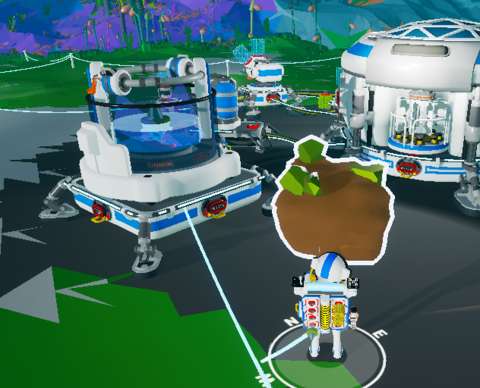
UNITS OF SOLID-FORM RESOURCES:
When they are collected, solid-form resources appear as bits of materials that are arranged around an invisible cylindrical core. Each cluster of these resources is a unit of them.
Any resource-producing device appears to accumulate bits of these resources until a full unit is completed. It then ejects the unit. The nuances – and problems – of this ejection will be described later.
Resource-consuming devices will consume units of resources, and only entire units of resources can be used. After a resource-consuming device has begun consuming a unit of resource, it must consume all of it. Until then, the partially-consumed resource unit stays on the input socket of the device. No other resource unit can occupy that socket, and the partially-consumed unit cannot be removed, at least not without a certain work-around that will be described later.
The units of solid-form resources may be generically cylindrical, but they will not be rolling around a lot. Indeed, they have considerable traction, such that they would only roll about if the surface that they are on is very steep.
OLD-FASHIONED DIGGING AND SEARCHING:
There are no means of remotely locating solid-form resources. This is despite the clearly advanced technologies that EXO Dynamic is providing to its astronauts. There are complaints among players that this is a problem.
Therefore, until the player has the means to build the Soil Centrifuge and the Trade Platform, the player must search around for the necessary resources to build these facilities. The Trade Platform, in particular, needs resources that are not on the starting world.
The player would have to depend on luck. This is due to the procedural generation of the worlds, which can place resources that the player needs in places that are not easy to reach or easy to find.
DIGGING:
Speaking of digging, the player character would be digging a lot with its digging tools. This large but peculiarly portable device (it changes its size readily) can draw in solid materials rather readily, with the exception of those that make up the unnatural edifices on the worlds.
The “Terrain Tool” – as the digging device is called – has a limited reach. However, its range is still generous enough that the player character can dig things that are many paces away. Indeed, the player can reach across chasms and mine the sides of cliffs.
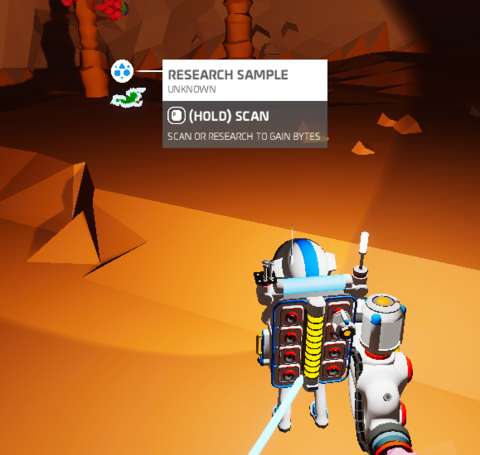
ACCUMULATING RESOURCES IN THE TERRAIN TOOL:
Any solid resources that the Terrain Tool digs up are immediately drawn into the tool. They accumulate on the socket at its rear. Until the extracted resources form full units, the Terrain Tool can store as many resources as the player would be extracting. However, the player does not get to see how many resources are within the terrain tool.
VEHICULAR DRILLS:
Vehicular drills are devices that can be mounted on vehicles that are called “Rovers”. The drills give Rovers the ability to dig. The player character can drive these vehicles while digging up earth.
However, drills do not have the reach of the Terrain Tool; as to be expected, they have to be used at close range. However, they have much greater throughput than the Terrain Tool.
Like the Terrain Tool, a drill has a socket that shows progress in accumulating solid-form resources. The drill can also contain as many partial units of resources as long as the player has not found enough to make full units.
The main advantage of vehicular drills over the Terrain Tool is that the drills can outright destroy most rocks and plants that are in the way, which makes for smoother digging.
ENERGY COSTS:
Any digging device consumes energy in order to operate. The Terrain Tool draws power from the backpack, whereas vehicular drills draw power from the vehicle’s battery. Without energy, the digging devices grind to a halt.
TRANSFER OF RESOURCE UNITS FROM DIGGING DEVICES:
Fully-formed resource units are transferred from the accumulating socket of the digging devices to elsewhere. In the case of the Terrain Tool, they either go to the player character’s backpack (more on this later) or to one of the other three sockets on the tool. In the case of the vehicular drills, the units are transferred to any storage device that is mounted on the vehicle. Otherwise, they are transferred to the player character’s backpack.
If there are no free sockets that the digging devices can transfer resources to, the resource units are simply dumped on the ground. They are not wasted of course, but this littering of resources can pose problems to the player later, especially if the player needs to make return trips with a vehicle. These resource units do have collision hitboxes, and can cause a bumpy ride if there are a lot of them in the vehicle’s way.
SOIL CANISTERS:
By default, any soil is removed with any digging tool is gone. With soil canisters, soil becomes a versatile resource. There are two types of soil canisters: the small and medium ones.
The small canister is attached to the Terrain Tool. This in turn enables landscaping functionalities, which will be described later. The medium canister is meant to be mounted on vehicles; it collects any soil that the vehicular drill has removed.
Soil canisters eventually fill up, but this will not stop any digging. Generally, canisters can only be emptied by emptying them into the Soil Centrifuge. This, and a minor problem, will be described later.
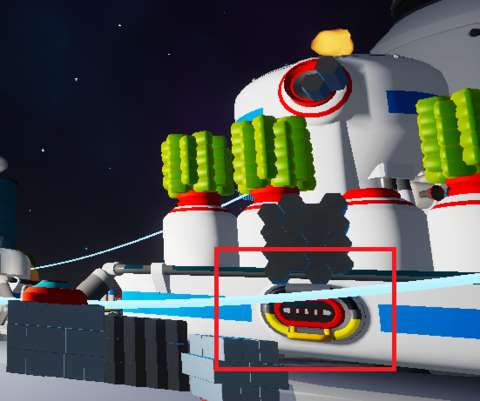
LANDSCAPING WITH SMALL CANISTERS:
Without a small canister, the Terrain Tool can only dig. With the canister though, landscaping functionality becomes enabled. There are other tool mods that can provide other functionalities; they will be described later.
The small canister enables two types of landscaping measures: adding soil onto any surface, or flattening the surface. Specific control inputs enable either functionality, upon which the targeting cursor for the Terrain Tool noticeably changes in appearance.
The soil-adding functionality is not as useful as the flattening one, however. There is usually little reason to use this, other than to make an unsightly dollop. The flattening functionality is much more versatile.
FLATTENING:
The flattening feature always create flat surfaces, obviously. There are two ways that it does so, depending on what the player moves the cursor into.
If the player moves the cursor into solid earth, the Terrain Tool removes soil and leaves a flat surface behind. Just enough soil is removed so that the player character can move onto the surface that is created. If the player moves the cursor into empty space, the Terrain Tool adds soil and leaves a flat surface behind. In either case, the small canister needs to have some soil in it already.
NO MEANS OF MANUAL ORIENTATION:
Neither the soil-adding or flattening feature has control inputs that allow the player to control the orientation of the cursor. Rather, the orientation of the cursor depends on the orientation of the surface that the cursor is over.
Thus, the player needs to add or remove soil until a surface with the orientation that the player wants has been made. This can be tedious.
OTHER TERRAIN TOOL MODS:
There are other tool mods that can be attached to the Terrain Tool, though each would take up a socket on the Tool. There are few reasons to use them, however.
There is the alignment mod, which alters the direction of the cursor as the tool digs into the earth. Specifically, by default, it makes the tool dig perfectly vertically. If the player uses the control input for flattening, the cursor realigns itself perpendicularly to any surface that it is on.
There is the wide mod, which widens the digging effect of the tool. This mod is useful for extracting resources on the surfaces of worlds, such as the plant-life.
There is the boost mod, which increases the digging strength of the Tool. However, it also increases its energy consumption. If the player wants to dig through soil rapidly and efficiently, the player is better off using a vehicle with a drill.
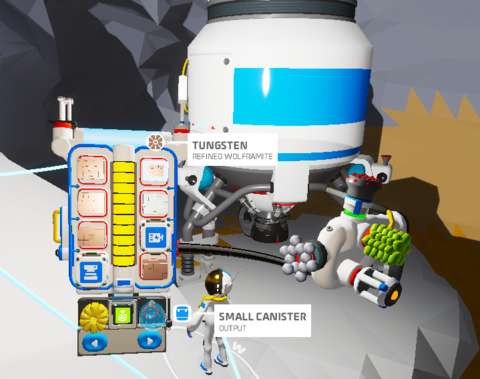
PAVER:
The Paver is a complement to the vehicular drill. Where the drill removes soil, the Paver adds and flattens soil. It must have a soil canister in order to work.
When mounted on the front of a Rover (there is no reason not to mount it on the front), the Paver allows the vehicle to practically move into the air as long as there is soil to build a platform with. Indeed, in the endgame stretches, a Large Rover with a Paver and a drill can easily let the player make paths to the edifices and the cores of the worlds.
Unlike the Terrain Tool, the player has some control over the alignment of the Paver, even though the control is limited to just one rotation axis.
If there is any issue with the Paver, it is that the wobbling of the Rover will affect the smoothness of the resulting surface. If the Rover is not moving smoothly, the surface would be uneven. The player can prevent this by mounting the Paver on the front and making sure that the Rover drives over what it paved.
BASE BUILDING - OVERVIEW:
The player character may be going places, but it must have a base that it can return to in order to make the assets that are needed to go places.
On the first world, the player character is given a Base Shelter for free. This one already has an energy source built in. There is also a special landing platform nearby that can be used to bring in the starter facilities.
Speaking of which, any base should have at least an Oxygenator and one of the 3D printers. The Oxygenator is needed to produce oxygen, which is channelled to any other building that is connected to it. The printers use the resources that the player character has collected to make devices that can be used.
FLAT SURFACES:
Flat surfaces are optional for base-building, but they are conducive to the efficient expansion of a base’s facilities. Inexperienced players might just use whatever surface that is close to the landing zone, but this would eventually cause trouble, the worst of which is things falling into the geometries of the earth.
PLATFORMS:
Right above the foundations that are flat surfaces, there are the platforms. Any base devices need platforms in order to function, because the platforms are the means through which energy is supplied to them. Platforms are also needed to make cable connections between the devices, and they are also the means through which tethers are powered (more on tethers later).
There are three sizes of platforms: one for medium-size devices, one for large ones and one for extra-large ones. Small devices automatically make platforms for themselves, conveniently.
Medium and large platforms always require resin, which in turn makes resin a resource that is needed throughout the game. Extra large platforms require processed resources, which make them a bit more of a hassle to get.
A wise player often makes enough platforms before going to another world that has not been visited. Having the platforms packaged would make the deployment of a base on the other world a much quicker experience.
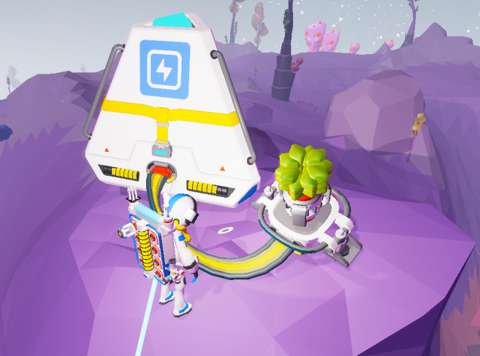
CABLE CONNECTIONS:
Platforms and vehicles have cable reels and sockets. The edifices on the worlds have these too, curiously. Anyway, these allow them to be connected to each other. The connections transfer power and, if they are connected to an Oxygenator, transfer oxygen too.
The cables can only be stretched out so far from their sockets. Obviously, if a cable cannot reach a socket, a connection cannot be made.
Even after a connection has been made between two objects (be they platforms or vehicles), there is the risk of the connection detaching if one or the other object gets too far away. This can happen if the earth under the object is dug away, causing it to fall. In the case of vehicles, the vehicle may roll away, causing the same problem.
If a series of connections is removed from a source of energy, the platforms and vehicles in that series will become unpowered.
FIDDLY CONTROLS FOR CABLE CONNECTIONS:
To make a connection, the player needs to select the cable from a socket and pull the plug of the cable out. The player’s aiming cursor becomes the plug of the cable. The player then needs to bring the plug over to another cable socket. If the plug gets into the vicinity of the socket, the plug would insert into the socket with an audible click.
This seems convenient. However, in practice, this is tedious. The main problem is the detection scripting for when a connection is counter-intuitive. Bringing a cable plug directly into a socket will not trigger an insertion. Rather, the player needs to hover the plug slightly away from the socket in order to trigger this.
SOIL CENTRIFUGE:
The Soil Centrifuge is one of the two facilities that the player will need if the player does not want to be randomly digging about looking for resources. The Centrifuge receives soil that has been stored in canisters. When the device is loaded with enough soil – the amount of which depends on the resource to be generated – it can generate certain resources without the player character having to go out looking for them.
The resources that can be generated include resins and compounds, which are among the most-used resources. They can also be rarer resources, like Ammonium and Graphite, but each unit of these require more soil than the other resources.
However, the Soil Centrifuge cannot make every resource. In particular, it cannot produce metal ores. That would be the function of another device, which will be described later.
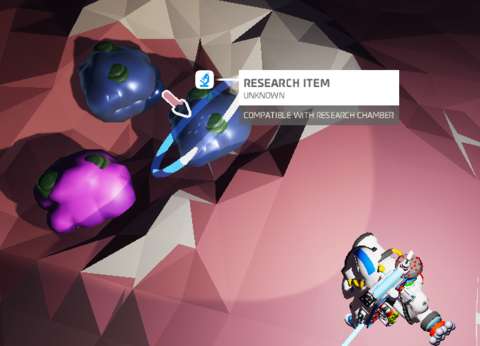
CAN ONLY USE SMALL CANISTERS ON SOIL CENTRIFUGE:
The Centrifuge has some caveats, most of which are manageable. For example, it is considered to be a “large” device, meaning that it needs to be mounted on a large platform. These are understandable setbacks.
The less-understandable setback is that the Centrifuge’s input socket only accepts small canisters. Medium canisters cannot be unloaded directly into the Centrifuge. This means that if the player wants to use soil from the medium canister, the player needs to manually load small canisters with soil from the bigger canister before loading the small canister’s contents into the Centrifuge. This is tedious, and also highlights the lack of automation in the game.
TRADE PLATFORM:
The Trade Platform is only available after the player has found a naturally-occurring source of Iron. After the player gains it, there is no more need to go out looking for naturally-occurring deposits of resources – as long as the player manages his/her resources carefully.
Anyway, the input resource for the Trade Platform is Scrap. Scrap can only be obtained through Shredders, which would be described later. The Trade Platform is the only facility that can consume Scrap.
Scrap can be traded for ore-based resources, or any of the resources that the Soil Centrifuge can make. The latter choices are usually not desirable, because the Centrifuge offers a faster solution. However, the option is there, just in the case the Centrifuge is somehow not available.
The Scrap so happens to be attached to a rocket on the platform, which then blasts off into space to presumably an EXO Dynamics facility. After a minute, the rocket returns to the platform; the platform must be settled somewhere and under the open sky for this to happen.
That said, the Trade Platform, curiously, does not have to be powered. It does not even need a platform. This is convenient, though it also means that the Trade Platform can slide down inclined surfaces or tumble along uneven terrain.
As for the ratios of the trade, they vary tremendously. For example, Sphelarite has a ratio that is favourable to the player, though Sphelarite turns into Zinc, which is not used for frequently needed things. For another example, Lithium has a ratio of one to four units of Scrap, which is expensive. This is just as well, because Lithium is used for a few endgame devices, which include the RTG (a power source that never runs out).
SMELTING FURNACES:
The Smelting Furnace is the first refining facility that the player gets. The Furnace is primarily meant to be used to refine metal ores, but it can also be used to turn Clay into Ceramic, Organics into Carbon and Quartz into Glass.
Any Furnace has four sockets for the purpose of queuing raw materials for refinement, but only one unit of resource can be worked on at any time. The order in which the processes take place is unclear, however; the Furnace seems to prioritize Organics higher than other resources, but other observations are not as clear.
Smelting Furnaces do not refine resources quickly, so they are likely to become the bottleneck in any process chain. It would not take long for players with experience in process management to have at least two of them.
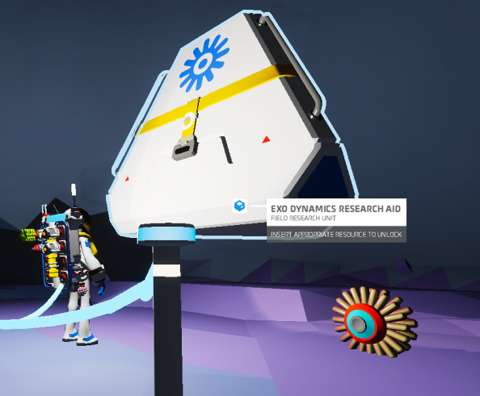
SHREDDERS AND SCRAP:
Shredders are needed to produce the Scrap that is in turn needed to make trades with the Trade Platform. The inputs for Shredders are not resources, but rather, any unwanted devices or salvage that the player has accumulated.
The size of the Shredder determines what it can crunch down and how many things that it can crunch down at a time.
For example, the Medium Shredder can only crunch down on small things and only one of them at a time. For another example, the Large Shredder can crunch on two small things, or one medium-size thing. The Extra Large Shredder has the greatest number of combinations, as to be expected.
If there is any issue with Shredders, it is that new players might be bewildered about how to place objects into the Shredders. New players might bring objects on top of the Shredders, because the top half of the Shredders are their business ends. The correct spot is their bodies; the game then positions objects above the Shredders’ crunch-rollers.
Extra-large objects cannot be shredded, because the biggest of the Shredders can only shred large objects. Therefore, any extra-large objects, like rocket shuttles, cannot be recycled. They can only be destroyed.
Shredders will never accept packaged objects. The packages have to be opened before the items can be fed to the Shredders.
MAKING DEVICES FROM SOIL JUST TO SHRED THEM:
The Soil Centrifuge, Smelting Furnace and Printers are the main means of getting things to feed into the Shredders. Ostensibly, the player should be looking for salvage to feed the Shredders, but that means going out exploring and risking the vagaries of the procedural generation for the worlds.
Therefore, a more practical and reliably repeatable means is to harvest soil or nearby resources, and then use the aforementioned devices to eventually make useless things to dump into the Shredders.
PROBLEMS WITH EJECTION OF RESOURCE UNITS FROM SMELTING FURNACE AND SHREDDERS:
Smelting Furnaces and Shredders have a significant problem in common. The problem is how refined resources are ejected from Furnaces, and Scrap from Shredders.
The problem is worse for Smelting Furnaces. The output resources accumulate in a socket that is directly above the sockets for input resources. The unit for the output resource can obscure the input resources, or the sockets for the inputs if the player is looking at the Furnaces from certain angles.
The Smelting Furnace and Shredders do not entirely fill up the platforms that they are on. Therefore, there is a chance that the resource unit that is ejected from the output socket would drop onto the platform, but becomes obscured by the model for the devices. Getting the output resources that are obscured can be tedious.
The ejected resource units also pile on top of each other. The newer ones may patter off the older ones, which can result in them tumbling to places that are bothersome to reach. Furthermore, if they pile up in front of the cable sockets of the platforms, there can be problems in selecting the output resources because the game prioritizes the selection of the cable plugs from the sockets.
The most outrageous scenario concerning this problem occurs when the player character is away from the base while the Furnaces or Shredders are processing a lot of resources. The game suspends the physics-scripting of anything that is far away from the player character (more on this later). Therefore, if the Furnaces are processing resources while the player character is away, the output resources accumulate in place. Removing one of the resource units causes the others to tumble down.
All of these problems are caused by the troublesome physics-scripting of the game. They could have been solved if the output resources automatically go into nearby platforms with attached storage devices. This solution could have been doable because there are already scripts for transferring extracted resources from digging tools into storage sockets. Unfortunately, the developers have not thought of this at the time of writing.
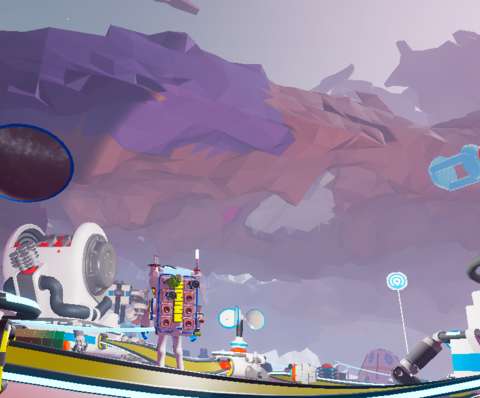
ATMOSPHERIC RESOURCES & CONDENSERS:
Atmospheric resources are contained within near-spherical containers, in order to differentiate them from solid-form resources. These containers are automatically created whenever the Atmospheric Condenser is used to extract gases from the atmospheres of the worlds.
The shape of these containers means that they are not easy to stabilize when placed on the ground. Indeed, it is easy for them to just roll off along their circumference to somewhere inconvenient. It is unclear whether this was an unintended consequence, or a deliberate design. Regardless, it is usually a good idea to stick the containers on storage devices, which are likely to be available when the player is able to make the Atmospheric Condenser.
The Atmospheric Condenser is the most energy-intensive device in the game. Turning it on will likely require at least one Medium Generator’s worth of energy output.
TETHERS:
Tethers are the means through which the player character’s backpack receives oxygen and energy from base infrastructure or fully-outfitted vehicles.
Tethers that are close to platforms that have energy and oxygen connections receive oxygen and energy too. In turn, tethers that are close to other tethers that are already supplied would be supplied too. This occurrence is presented through visually obvious means, namely the bright coloured conduits between the tethers.
Tethers do not consume any energy or oxygen, so the player can have as many tethers around a world as he/she likes.
If the player character is close to a tether, or a supplied platform, a conduit appears from the player character’s backpack. This conduit connects to the conduits of the tethers, the tethers or the supplied platform, whichever is closer.
Tethers attempt to adhere to any surface that they are planted on. They can even be planted upside-down. However, as soon as the surface that they are on is manipulated, their anchors come off. This can result in them tumbling away and breaking the connections between the tethers.
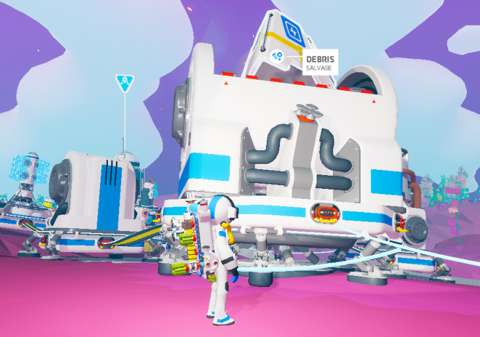
METERS ON MODELS:
An observant player might notice that the visual display of the game does not have any on-screen meters, numbers or other indicators.
Rather, these indicators appear on the models of objects, including the player character. The most important of these is the horizontal cylinder on the top of the player character’s backpack; this represents the amount of oxygen that the player character has left.
There are also the circular meters on the top of canisters that indicate how much soil that they have. The cylindrical bodies of the canisters are also transparent; they are slowly filled with light grey stuff as they store more soil.
Meters being meters, they rely on coloured fills versus fills of other contrasting colours. In most cases, the colour fill for empty capacity is black, or transparent void. These provide acceptably functional visual contrast.
RESIZED AND REALIGNED MODELS AS USER INTERFACES:
Although there are no on-screen visual indicators, there are the user interfaces (UIs) on the control panels of devices. These are actually parts of the devices’ models. When the player examines the devices, these parts of their models increase in size and reorient themselves such that the surfaces of the UI’s are within the camera’s view. These UI’s follow the camera around as long as the player is close to the object that is being examined.
These UIs are still part of the game world and are subject to the local lighting conditions. The UIs do have screens and buttons that have their own lighting, however. Their graphics also take precedence over any other visuals, so the screens and buttons are always visible, which is fortunate.
Some of these user interfaces also have meters, which are used to indicate progress on something. For example, the Research Chamber’s UI has a meter that shows the progress on analysing a research sample (more on research later). However, unlike the meters on the models of objects, they use colour fills that are not black for progress that has yet to be achieved. This can be a problem for colour-blind people.
ENERGY MANAGEMENT:
In the coding for the gameplay, the generation and consumption of energy are measured according to defined units. Unfortunately, these units of energy are not presented to the player in numerical ways.
Rather, all the player sees are quarter-circles around the cable sockets of the platforms and vehicles. If the bottom two quarter-circles around the sockets are fully yellow, any devices onto the platforms and vehicles are fully powered. If it is partially filled, there is not enough power; the devices will work at rates that are proportional to the fills.
If the upper two quarter-circles are filled, including partially, there is enough energy to go around for devices to work at full performance. Having extra energy does not increase their performance.
All devices that are connected to each other through their platforms share the same energy supply status. Fortunately, this design simplifies energy management.
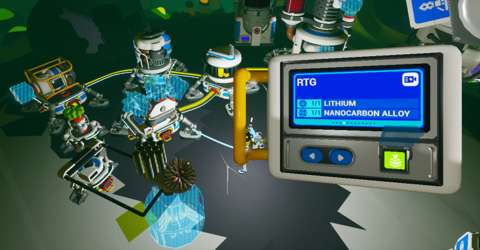
GENERATORS:
Generators are the main source of energy for bases. Prior to the acquisition of RTGs, the player would have to depend on generators to provide reliable energy supplies. However, generators consume fuel; small generators consume Organics, whereas medium generators consume Carbon. Minding them can be a bit tedious, but at least the player can turn them on or off.
The RTGs are the ultimate generators. These never run out of fuel and can run indefinitely. However, the process chain that leads to their manufacturing is very long, if the player cannot find rare resources such as Lithium and Titanium. Still, getting RTGs is practically a signal to the endgame.
Incidentally, the starting Shelter has an RTG permanently installed; it cannot be removed. However, this is not told to the player in any way. In fact, the game does not inform the player that the starting Shelter is the thing that is giving energy to the base and the player character.
SOLAR AND WIND POWER:
There are devices that derive energy from sunlight and wind. Obviously, these power sources are only deployable on the surfaces of the worlds. There is a range of sizes for these devices. There are small ones that the player can mount on the player character’s backpack, for example. For another example, there are extra large solar panels, which can reach higher energy outputs than even RTGs, if there is enough sunlight on the world.
However, solar and wind power is, understandably, dependent on transient weather. The night-and-day cycles are incredibly fast. Wind is unpredictably fickle. These make batteries a much needed addition to any bases that are running on solar. Furthermore, solar and wind power is only available on the surface.
BATTERIES:
Batteries collect any surplus energy from a base’s infrastructure when the devices are sufficiently powered. There are two types of batteries: small and medium. The difference in capacity between the two is so considerable that the player would be wise to use medium batteries in bases.
When the infrastructure of a base cannot supply enough energy, any batteries that have energy turns into a power source. Small batteries produce power that matches small generators, whereas medium batteries match medium generators.
SOCKETS ON BACKPACK:
There are sockets on the backpack for the purpose of either storing resource units or attaching small devices to the backpack. The player is shown this when the player brings up the user interface for the backpack (which causes the backpack to inflate its size and orient itself to be perpendicular to the camera, much like the control panels on other devices).
The player character becomes slower on the move when this happens, however. This might not be a wise thing to do when there are aggressive flora around.
Anyway, there are eight regular sockets for storing small items. Any devices that are attached to these sockets can be activated when they are selected, but can only be activated after bringing up the backpack UI.
There are also two special sockets, which are mounted on arms that are sticking out of the top of the backpack. Any devices that are mounted on these arms can be activated with two control inputs, the same ones that are used to rotate objects that are being held (more on this later).
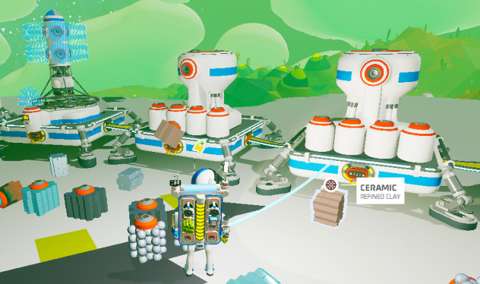
BACKPACK PRINTER:
The bottom of the backpack has a particularly tiny and portable printer. It has an input socket, which can be used to store input materials as long as the correct manufacturing option is selected. The manufacturing can only happen if the backpack has enough power for the process. Different items need different amounts of energy, but how much these are happen to be unclear.
Anyway, the manufactured product appears in the output socket. However, when it is completed, it will be moved into one of the other sockets on the backpack or the Terrain Tool, if there are any available. Otherwise, it just falls onto the ground.
The player only ever has one backpack printer, so any process chain that involves the backpack printer will eventually lead to the backpack printer becoming the bottleneck. Still, the backpack printer is the fastest printer in the game.
SOCKETS ON PLATFORMS & VEHICLES:
The base platforms have sockets. Larger platforms have the sockets seemingly connected to each other with red reliefs. These indicate that they can hold objects of larger size, which take up more sockets. If the red reliefs are not there, that would mean that the sockets can only support the attachment of small objects.
This is important to keep in mind when expanding bases. However, the game does not teach the player about this.
Vehicles have similar sockets. In the case of Rovers, they have sockets on their front and rear faces too. Bigger vehicles have socket arrangements that are more complex. However, as big as any vehicle can get, no vehicle can support the attachment of extra large objects.
PACKAGES:
When any devices are made, they automatically come packaged. These packages are always one size smaller than the devices, meaning that they are easier to transport about than the devices themselves. Indeed, if the player intends to travel to another world to build a base, the player might want to carry any pre-fabricated devices in packaged form.
Small devices do not need to be packaged, and cannot be packaged in any way either. They can be readily placed into any socket.
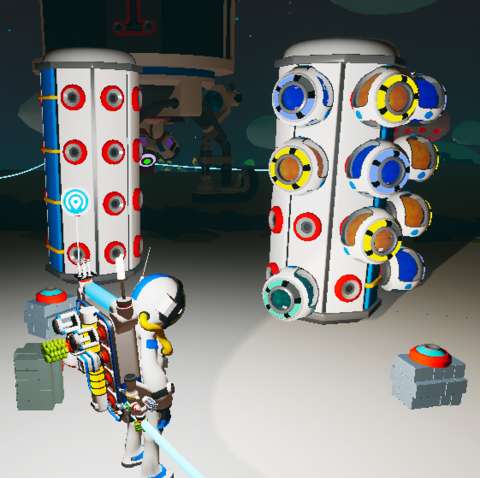
PACKAGING:
To package already-deployed devices, the player needs Packagers, which are made from Graphite, of all things.
Packagers can also be used on other things, namely some of the things that the player may forage during exploration. For example, large pieces of salvage can be packaged into medium packages, which can then be attached to any suitable transport.
Devices that are performing a function cannot be packaged until they complete their tasks. Very large objects, such as wrecked ships, also cannot be packaged.
PACKAGING REMOVES PARTIALLY-CONSUMED RESOURCES:
There is a peculiarity that is not informed to the player. A device that is extracting or refining resources may have incomplete units of resources. If the device is packaged, the partially complete resource unit is lost. This also applies to medium soil canisters.
NO AUTOMATION:
Players who have played Factorio or Satisfactory (especially Satisfactory) may notice the absence of any options for automation. Indeed, many things have to be done manually, like the processing of raw resources into refined ones and making things out of the latter resources.
Fortunately, unlike the aforementioned two other games, the costs of making things are relatively low. Even extra large objects only need a handful of solid-form resource units. Thus, the busywork only lasts for a short while.
This still makes for a thematic contrast that may be dissatisfying though. The tech that the player character is obviously very sci-fi – yet automation is not available in any way.
PHYSICS – FOREWORD:
Now, the most frustrating aspect of the game would be described: its physics-scripting.
Collision hitboxes are the most frustrating aspects of the physics-scripting. Gravity and traction are less egregious, but they are not entirely and reliably predictable. These will be described further later. There are other aspects that are not as frustrating, mainly because the developers actually thought about suspending physics for ease of gameplay. These will be described later too.
HOLDING/LEVITATING OBJECTS:
One of the earliest things that the player would notice is that the player character can somehow hold out its hands and levitate things. The things can include huge objects, like rocket shuttles. However, the variety of huge things that can be levitated are limited to EXO Dynamics assets.
The player character will not be levitating certain things, regardless of their size. These include terrain objects, like the rocks that are dislodged during digging. Fortunately, most of these are dealt through conveniently automatic means, which will be described later.
Anyway, objects that are being levitated are rendered incorporeal, i.e. their collision hitboxes are disabled. The objects completely clip through anything, which is convenient. The objects can become obscured if they clip into terrain, but there is a line that is drawn between the player character and the objects to indicate where the objects are.
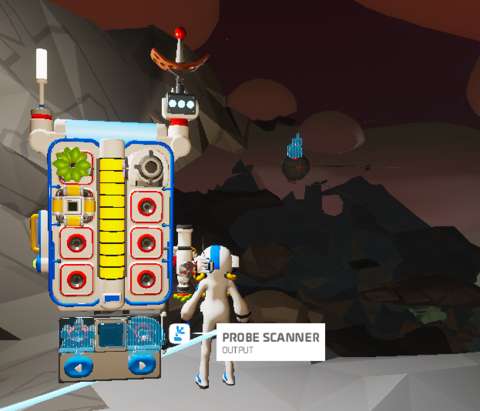
PLACING OBJECTS:
Placing objects that are being levitated is a different matter. The game draws a circle below the objects, exactly at the spot where they would be dropped. However, the circle can be obscured by other objects. The player’s depth perception is the only factor that the player can rely on (if it was reliable at all), because the game is not reliable at helping the player in this matter.
The game will automatically orient the levitated objects if they are brought close to other objects that can interact with them, assuming that the player is bringing them into the hitbox that triggers the orientation. The example of cable heads being inserted into cable sockets has been described already, as are the problems with putting things in the Shredders. Another example is a resource unit being directed into a socket when it is brought close to the latter.
However, there are times when this automatic orientation turns out in ways that the player does not want. For example, if there is a storage device that is just behind the player character but that is not seen because the camera renders it invisible, bringing up a levitated object may cause the game to interpret that the player is trying to attach object to the storage device. This can be annoying.
HOLDING OBJECTS:
Levitating objects causes the player character to move slower. Larger objects reduce speed even more; huge objects like rocket shuttles outright root the player character to the spot.
As an alternative to levitating things, the player character can hold them in its hands. The player character can only hold up to medium-sized things, however, though their weight and shape do not matter. Holding objects lets the player character move faster than when the player character is levitating things. However, if the object happens to be wide and/or tall, it might obscure the player’s view of what is ahead.
That said, levitating things is still necessary for having them inserted into sockets or connecting them to other objects.
GRAVITY:
As to be expected of video game gravity, gravity in this game causes objects that are not resting on surfaces or held up by something else to fall downwards. Specifically, it will fall in a direction that is along a radial line that is drawn from the object to the core of the world. Of course, the object would still have any momentum that it has prior to falling, if any.
There is generally no reason to make use of gravity, however. There is nothing that can be gained from having things drop from a great height.
Of course, if the player character falls from a great enough height, it dies. Other things do not appear to be affected by falls, however. Indeed, wily players might get into a rover seat that is just about to fall down long distances in order to descend quicker.
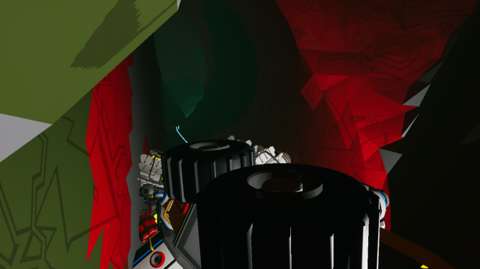
TRACTION, TUMBLING & STEEP SURFACES:
If an object is resting on a relatively horizontal surface, it will not be going anywhere unless it rolls. Even rolling objects would eventually slow to a stop.
However, if the surfaces are steep enough, the object begins to roll. Different objects have different traction in these cases, though noticing the differences may not be easy to a new player. For example, spherical objects have the least traction because they are prone to rolling. For another example, the low and blocky units of Carbon do not tumble down steep surfaces easily.
Speaking of tumbling, tall things readily tumble down any inclination. The Medium Storage Silos are particular aggravating examples, due to their radius to height ratios.
The worst offender is the medium canister. The canister does not have any flat bottom, meaning that it will always incline in one direction or another when it rests on any surface. They will always tumble down steep surfaces, consequently.
Interestingly, the player will rarely if not never see any sliding objects, at least not outside of physics glitches.
DISABLING OF PHYSICS:
The game has objects, contours and other things persisting throughout the entire solar system. This can be a burden to compute. Hence, to reduce computing overhead, only objects with a certain distance of the player character has active physics-scripting. Things further away are frozen in place where they are when the player character gets far enough.
This is generally not an issue. If the player returns, physics is re-applied, e.g. anything that happens to be falling will begin falling again.
However, the output of Smelting Furnaces is another matter. It is possible for multiple units of resources to accumulate at the output sockets of the Furnaces, within the same spots. This causes their physics-scripting to glitch, causing them to remain frozen when the player character returns to the Furnaces.
EXPLOSIONS:
There are some aggressive flora that either explodes when the player character gets too close or shoots explosive seeds at the player character.
Explosions are obviously dangerous. If the player character is caught too close to the epicentre of one, it dies outright. Worse, if the player character’s backpack has explosive materials, like Hydrazine, they will ignite shortly, which guarantees the player character’s death.
Explosions can also damage vehicles and eventually destroy them. Indeed, most objects can be destroyed with explosions. Hence, the player might want to be mindful of where explosive things are, especially the aforementioned flora that fire explosive seeds.
The player can also indulge in some explosive shenanigans, mainly through the use of Dynamite. Wiser and more efficient players would find little reason to use them though; more often than not, circumventing obstacles is a smarter and faster solution than trying to blow them up.
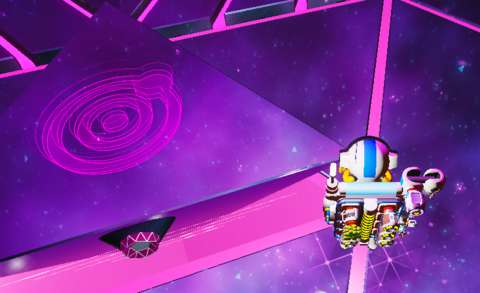
INDESTRUCTIBLE OBJECTS:
Some objects cannot be destroyed, even with Dynamite. For example, the world Vesania has large and strange-looking egg-like objects that cannot be destroyed. These objects cannot be moved around either, not without making use of gravity and traction.
These objects can be bothersome, especially if they get in the way of vehicles. Returning to the example of Vesania, the egg-like objects can block the path of vehicles readily.
These objects are also greatly subjected to the unpredictable physics-scripting in Astroneer. There is the example of the egg-like objects on Vesania again; these objects are generally partially in the ground before they are dug up. The sudden release from the soil around them can cause them to spring up and bounce around, sometimes rapidly. Fortunately, these objects do not cause contact damage when they collide with the player character or vehicles.
RESEARCH:
EXO Dynamic may have prepared a lot of tech for its Astronauts, but they are not available from the get-go. It is not entirely clear why this is so, but the mechanisms for what passes as “research” in this game strongly suggest the following.
The player character’s database cannot support the presence of the schematics for all the techs, at least not initially. It has to be improved by somehow deriving data capability from the analysis of samples from the worlds, or “research aid” from EXO Dynamics. The data capability is then expended on registering the schematics from EXO Dynamics.
The amount of data capacity that the database has accumulated is represented as “bytes”, likely with intentional humour on the developer’s part.
Understandably, later-game tech requires more bytes. The starting world has research samples that are good enough to unlock early-game tech, but unlocking later-game tech with this can be slow and tedious. The research samples from other worlds have much greater value and yield over time, so there is an incentive to go to those other worlds.
NATURAL RESEARCH SAMPLES:
The worlds in the solar system have no fauna, but considerable diversity in flora. The flora produces peculiar fruits and flowers (or at least they are presumed to be so), which make for interesting research subjects. Similarly, some plants happen to have large tubers that also make for viable research samples.
There are mineral clusters that can be found as (presumably) secretions from the plants, or among rock-croppings somewhere underground. These mineral clusters cannot be harvested for resources, but can be brought back for research.
“RESEARCH AID”:
As part of their programme to garner whatever it is that they want from the solar system, EXO Dynamics has seeded the worlds with what are called in-game as “research aid”. It is apparent that these are there to give high-value research samples to the player character, but the narrative reasons for their presence is not entirely clear.
Peculiarly, the “research aid” comes in capsules that are not readily accessible. They cannot be picked up, and have to be physically manipulated by removing and adding terrain around or under them. This is necessary, because the player must be able to access the socket on one of their three non-bottom facings.
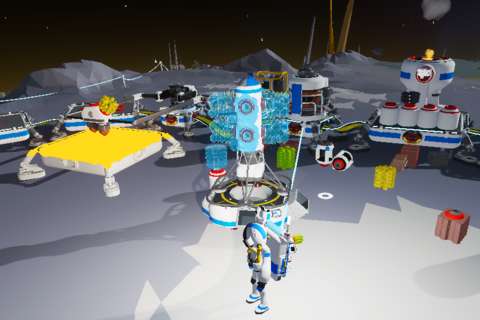
This socket can be a socket to attach resource units to. The player needs to attach the correct resource unit; the clue for this is the symbol on each facing of the capsule. If the correct resource is used, it will be consumed and the capsule will open. If the resource is an atmospheric resource, the container that is attached does not need to be full; the player can use a container with just one charge of gases left.
It is unclear why the capsules even need the resources in the first place, but these are understandably there so that the player has to do some busywork before being able to open them.
Alternatively, the capsules may have cable sockets instead. In the case of these, the player needs to supply them with energy. Since the capsules cannot be moved, the player must have a mobile energy supply, likely via a rover that has been kitted out with generators.
That said, there are two variants of these energy-absorbing capsules. One variant has what appears to be a battery, which has to be fully charged before the capsule opens. The other variant is more troublesome; it needs to be powered by a specific rate of energy input, meaning that the player needs to have significant portable energy sources.
Opening the capsules yield high-value research samples. The easier worlds yield small samples, whereas the more difficult ones like Atrox yield larger but more valuable samples.
SCANNING SMALL SAMPLES:
Some research samples are physically small enough that they can be attached to the player character’s backpack. Actually, there is no reason to do so, because any additional value to be had from bringing them to base is so small that it is not worth the trouble.
For this scenario, there is the option of scanning the small research samples. They disappear within seconds, but give the player their bytes. The player could get more by returning them to a Research Chamber, but generally the increased pay-off is not worth the trouble and time.
RESEARCH CHAMBER:
The Research Chamber is the device that the player needs to analyse the larger research samples, which cannot be scanned on the spot. A Research Chamber can analyse only one sample at a time, and it takes a while to do so. Even small samples take minutes to be analysed, hence the aforementioned reason of not bothering to bring them back to base.
The Research Chamber also consumes considerable energy. Since it takes a long time to analyse any research sample, the Chamber would be putting a load on the base’s energy supply. Indeed, the player might want to think twice about having another Research Chamber; the combined load can be considerable.
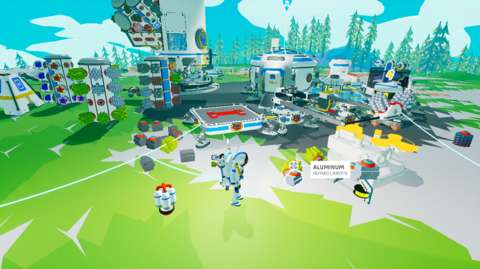
TROUBLE WITH RESEARCH AID CAPSULES:
As mentioned earlier, Research Aid capsules cannot be moved, at least not directly. Their shape also makes them difficult to push about. If the player’s expansion schemes or road-paving plans run into these, the player has to either go around them or deal with them.
When they are opened, the top halves can be levitated about. However, despite their seeming size, they count as large objects. They can produce a lot of Scrap, but getting them back to an Extra Large Shredder (which is definitely not portable) can be tedious.
The bottom seats of the capsules are even more problematic. These cannot be manipulated directly and they cannot be packaged. Their shape makes for troublesome collisions and also makes them difficult to be moved about indirectly. Fortunately, they can be destroyed with Dynamite, but that also means having to carry Dynamite around for this purpose.
DISAPPEARING ROCKS & PLANTS:
Rocks, stalagmites, stalactites and large plants cannot be broken down into resources. Rather, they just get in the way when they are dislodged from digging the earth around them. Fortunately, the developers have realized that this is an issue, so they have scripted these to disappear shortly after they are dislodged. Having them disappearing suddenly can seem disconcerting at first, but this is for the betterment of the gameplay.
COLLISION PHYSICS:
Some of the most frustrating physics-scripting in the game are collision physics. For small object like resource units, this is generally not an issue. However, anything larger is subject to the gaps in coding that the developers did not foresee.
The players of this game have already come across silly bugs where objects seem to rebound off other things at alarmingly fast speeds. This can happen to the player character too, when it is seemingly walking over objects. This usually means death when they land.
The worst offenders are the aforementioned bottom halves of opened research capsules. Walking or driving over these can occasionally cause the bottom halves to rebound, and then the model for the player character or vehicle somehow registers a rebound from these too. This can result in faulty physics that launches the player character or vehicle into the air.
The problems with collision physics mean that it is generally wise to make flat and smooth paths to wherever the player needs to go to, especially if the player is using a vehicle.
BITS LEFT BEHIND WHEN DIGGING:
Any solid cluster of polygons still has collision properties – including any small bits of earth left behind when digging with the Terrain Tool. These small bits continue to stay where they are, appearing to float in mid-air. This can be a problem if the player intends to drive vehicles through places that have been dug out using the Terrain Tool.
Fortunately, the lighting for the game’s graphics is such that these small bits will cast shadows, which make them much more noticeable. Still, removing them is tedious.
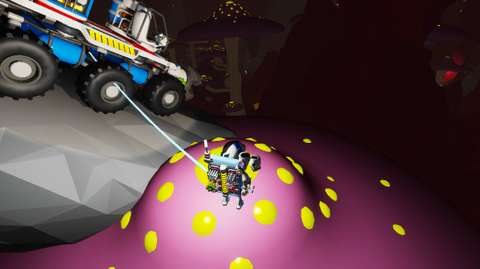
VEHICULAR MOVEMENT:
The forwards and backwards control inputs are converted into acceleration and deceleration when controlling vehicles. This is not well-documented in-game, and is definitely not told to the player.
Vehicles generally have considerable traction; when they are at full stop, they are impossible to move, unless the terrain underneath them is manipulated. This is fortunate, as losing vehicles due to mishaps can be major setbacks.
Unfortunately, all vehicles do poorly when moving across uneven terrain. They tumble across such terrain, making them very unreliable to use along anything that is not paved.
A vehicle that is upside-down is inoperable. Fortunately, the vehicle can be flipped over with the press of a button.
VEHICLE ACCELERATION DOWN RAMPS:
Making slanted ramps are a good way to have vehicles go down into the depths. However, they also accelerate, which can cause them to build up speed, possibly to uncontrollable levels. Fortunately, the deceleration control inputs work reliably, so controlling the descent speed is as simple as tapping that control input whenever the vehicle gets alarmingly fast.
SLIDING:
The only portion of the game’s physics-scripting that is actually fun and useful is the sliding animation for the player character. When the player character travels down a ramp fast enough, it starts to slide. This lets the player character move down ramps faster, at the risk of slipping off ledges and possibly falling to its death.
Nonetheless, the control inputs for sliding inputs are surprisingly reliable. If the player has made ramps that have predictable paths, the player character can slide down them rather readily. Furthermore, like vehicles, the player can slow the player character down with the tap of a button.
SURFACE EDIFICES:
The aforementioned unnatural edifices have been given the names of “Gateways” by the developers and player community. This is mainly due to what they can do after they have been activated, which is that they can transport the player character around in between them.
The edifices on the surface do not distort physics. These are the ones that the new player should interact with first. As mentioned earlier, these have cable sockets on them, which can seem odd. That said, the player would be using these to power up the edifices. After they have been powered up, they will open the way to the core of the world that they are on.
Alternatively, the player could find the rest of the surface edifices on the world and activate them. There is little reason to do so, unless the player intends to build new bases on the same world, for whatever reason.
PILLARS:
If the player digs below the edifices, the player would eventually find spiralling pillars. These pillars exert gravitational pull, causing anything that touches them to stick on to them. This can be entertaining, disorienting or both.
The pillars will spiral downwards towards the core of the world. This is where the player should go next. Indeed, the player could just dig along the pillar, following its contours to the core.
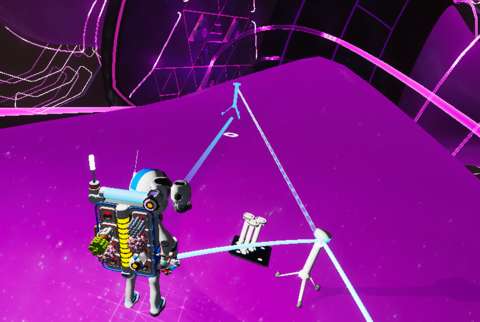
PILLARS ARE BAD FOR VEHICLES:
Small objects like the player character has no problems adhering to the pillars. However, vehicles are rendered near-useless. This is mainly due to the helical shape of the pillars, which causes the vehicles to tumble a lot. This can be even more disorienting.
The worst case is when the player’s digging rover stumbles into a pillar. This immediately causes the rover to adhere to the pillar, which can be sudden and understandably disorienting. Coupled with the tight spaces which are to be expected when digging under-ground, this can be outright nauseating.
REDUCTION OF GRAVITY AT GREATER DEPTHS:
The physics engine of the game is sophisticated enough to render the mantles of the worlds. The mantles are separated into several strata, each with noticeably different gravitational pulls. Generally, gravitational accelerations reduce with depth.
Reduced gravity increases the distance that player characters can fall before damage is inflicted, it also reduces their falling speed, and speed of sliding down ramps too.
In the case of vehicles, their inertia is noticeably reduced. This makes turning problematic. Indeed, the inexperienced player might run into mishaps such as making turns that are wider than expected.
Eventually, wise players would have to come up with policies for digging underground, like having only straight paths at manageably shallow angles. This is in order to minimize the number of complications that can be frustrating and headache-inducing.
THE CORES:
The cores have even zanier gravity. The cores are where spherical edifices occur; these are called “Engines” in the lore of the game.
In order to access the Engines, at least one of the surface edifices must be already be activated. Otherwise, its internal surfaces are shielded by barriers that cannot be penetrated in any way.
The player character will adhere perfectly to any surface on the Engines of the worlds. Interestingly, the player character’s oxygen consumption is also suspended when it is moving about on its surfaces; this perhaps has been implemented in order to make it easier for players to study the Engines.
Any Engine has internal surfaces that are always arranged in the following manner: two parallel surfaces opposite to each other, connected with parabolic walls. The parallel surfaces have daises that the player will want to interact with.
One of the surfaces has three daises. The daises have resource symbols on them; of course, this is a cue for the player to have the relevant resource ready. Not doing so means a return trip back to the surface, which can be daunting (though the player can get lucky, e.g. having the resources occurring near the core). Inserting the resource units into any of the sockets on the daises causes the units to be consumed. A peculiar artefact, called “triptychs” in-game, will appear.
However, this raises the aforementioned shields, thus trapping the player character inside. The only other thing left to do – other than making more triptychs – is to put a triptych into the odd-one-out dais, which happens to be on the opposite surface. This activates the core, making it function like the other teleportation edifices. This also lowers the shields, though the player can continue to make triptychs.
There is another gameplay design about the triptychs that will not be described here, because it is a spoiler and one that is not too woven into the gameplay.
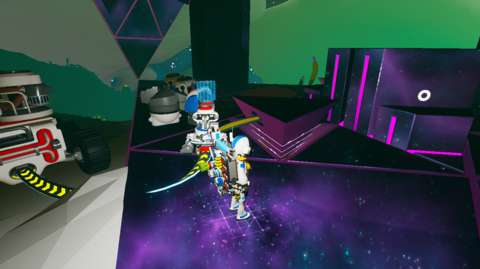
DANGEROUS FLORA:
There may be no fauna, but there is a variety of dangerous flora on the worlds. Different worlds may share the same species, though individual specimens may belong to one of the multiple variations of the same species.
Most of them usually have some alarming visual designs as a warning about what they can do. Glowing red and in the dark is the most reliably noticeable of these.
As for what they do, some of them do what they do when the player character is close enough to them. Otherwise, they just sit in place. For example, Attactus plants will fire their seeds at the player character if they are within range.
Some others only activate when the player character is doing what it usually does, like digging. For example, the Popcorals explode whenever the player digs too much of the soil around them; bigger corals have bigger explosive radii.
All dangerous flora can be defeated by simply digging up the soil around them. Somehow, this causes them to pop (more so for the Popcorals). They leave behind small research samples, and sometimes seeds, which the player can replant in the hope that they can perpetuate a cycle of yielding research samples. If the player is lucky, a plant that has grown much (and is thus rather dangerous) may yield large research samples when they are dug out.
PLANTS ARE NOT AWARE OF VEHICLES:
If the player character is in a vehicle, the aggressive flora does not appear to respond to the proximity of the player character – or the vehicle for that matter. It is unclear whether this was a design oversight or a deliberately-imposed limitation.
That said, this makes exploration via vehicles much easier. For example, the player can drive a large rover with a drill and paver around and run over almost any dangerous plant in the way without much trouble.
SPACE TRAVEL:
Last and perhaps least of the gameplay is space travel. The player character cannot readily go into space, so there are space shuttles that can be built to facilitate this. However, if the player is expecting some kind of sophisticated space travel mechanism, the player would be mistaken.
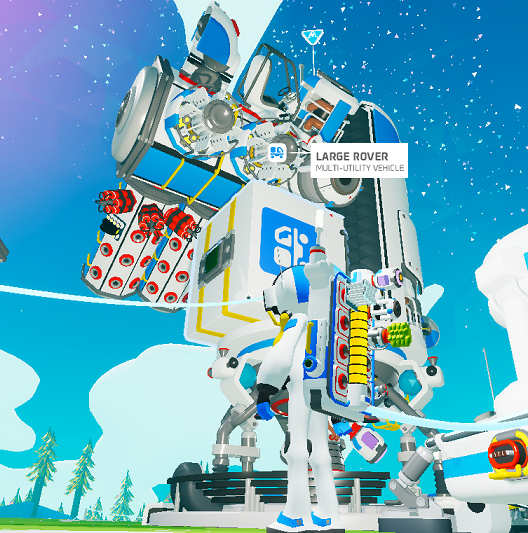
Space travel is as simple as getting into a rocket shuttle and launching it off. This takes it into the orbit of the world that it was on. From here, the player can choose to land on other landing zones on the world, though there is little reason to.
Entering the control input for launching again zooms out the camera, showing a portion of the solar system. This is not told to the player, unfortunately, so uninformed players would have to press this and that key until something happens.
The player has to rotate the camera in this zoomed-out view in order to locate other worlds. This would not have been necessary if the player is simply shown a map of the solar system. Besides, the zoomed-out view does not add much to the gameplay anyway.
Anyway, the player selects the next world to travel to. The shuttle will go there as soon as the world is selected. There is no query for confirmation. Unfortunately, as straightforward as it sounds, it is actually problematic.
The zoomed-out view does not provide the player with a good look at the worlds that can be travelled to. The moons, in particular, can seem small. The player can zoom the camera in, but the worlds are moving in real-time, meaning that they can move out of the camera view anyway. Hovering the mouse cursor over the worlds does bring up tooltips, but the worlds would eventually move away from under the cursor.
MULTIPLAYER:
Astroneer uses the network coding for whatever platform that it is on, such as Steam’s network in the case of the Steam version of the game. Players can join other players’ sessions. The host can determine whether they can alter their game-world or not, though the multiplayer experience is better off if the guest players can do whatever the host player can do. After all, the host can easily have any miscreant kicked out.
Unfortunately, communication between players can be a problem. There are emotes, but any player character can only have up to four of these, and they are not always useful for conveying the idea of the message that they want to get through. Rather, the developers expect the players to use third-party software, like Discord, to communicate with each other; there is a Steam forum thread where one of the developers expresses this.
This is a rather unfortunate design omission. Perhaps the developers might want to believe that this is the sign of the times, but having to run third-party software together with the game itself would lead to additional consumption of computing resources. The reliability of the multiplayer experience would also need to depend on other software. Most importantly, the game itself could not take the bulk of the credit for any fun experience that players would have; services like Discord would deserve some of that.
BEACONS:
In both single-player and multiplayer, player characters, shelters, shuttles and beacons project symbols above them. For the sake of convenience, these will be referred to as “beacons”.
The beacons are supposed to be there for the player to spot over long distances. However, beacons do not take priority over other visual assets. This means that the beacons can be obscured. In particular, the player will never see beacons that are underground when the player character is in orbit.
Considering that there is no mapping system whatsoever, the beacons would have been useful for getting one’s bearings. Unfortunately, this is not the case due to the aforementioned problem.
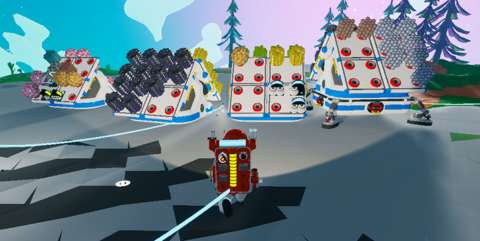
VISUAL DESIGNS:
Astroneer does not use cutting-edge graphics, but that is perhaps for the better because its game world visually deforms as the player manipulates it. If the game had used cutting-edge graphics, the computational overhead would have been burdensome.
That said, Astroneer uses voxels. These cluster together in order to give the semblance of smooth models and surfaces. They also conveniently allow the application of particle effects, lighting and shadowing. Indeed, if the player tweaks the graphical settings and observe the changes, especially those from changes to the settings on post-processing, the player can see how the latter are applied.
On the other hand, there are some noticeably simplistic designs in the visual assets of the game. For one, many resources share the same models. The only visual differences among resources that have the same models are their colours, which can be a problem for the colour-blind.
Not many things can move; after all, the solar system that the player character is in is completely devoid of fauna. The native plants do have animations, but most of them just undulate. The ones that have significant animations are the aforementioned dangerous flora. Indeed, if a new player sees a close-by plant showing sudden movement, that usually means that it is dangerous.
The player character gets the bulk of the animation work. It is clearly humanoid, with limbs that move about in mostly convincing ways. There are no facial animations of course, on account of the helmet that it is wearing. The emotes give it personality where its non-visible face could not, but as mentioned earlier, a player character can only have a limited number of emotes.
SOUND DESIGNS:
The player characters have voices of sorts, but they make illegible noises. The only situation where these noises are useful is in multiplayer, because they reveal the proximity of other player characters and that they are trying to indicate something to the player.
The music is perhaps the best part about the game’s sounds. They are pleasant to listen to, and will change tracks in order to indicate any changes in the player character’s surroundings and situation. For example, as the player character gets closer to the core of a world, tracks with more wondrous tunes begin to play.
Each of the worlds has its own set of sound effects for its inclement weather. For example, being the most temperate of the worlds, Sylva has the most pleasant sounds, such as the soft breezes of its winds. In contrast, Calidor has howling winds.
The sounds that the player would want to keep an ear out for are the dings, beeps and other noises made by the machines back at the base. These of course indicate that they have performed their functions, which is just as well because it is unlikely that the player can arrange them such that the player can see all of them at once.
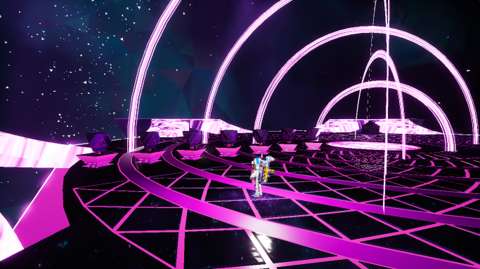
SUMMARY:
At this time of writing, Astroneer has a lot of problems concerning user-friendliness. Lack of thorough tutorials and unpredictable physics can make for frustrating moments that would have players looking at forum threads and wikis for the game. Of course, many of these can ostensibly be rectified. However, as of now, it is difficult to recommend this game to anyone who puts quality-of-life concerns at the top of their list of priorities.
That said, if the player could endure all of the aforementioned problems, Astroneer offers an experience that is in contrast to other sandbox games, which tend to overwhelm players with lots of mechanisms and concerns. In other words, Astroneer is a comfortably easy and streamlined sandbox-exploration game – as long as the player does not learn about this game’s problems in the worst of ways.

